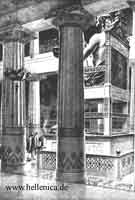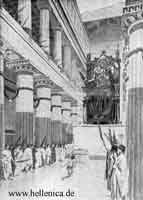.
Klassische Griechische Kunst: Die Zeus Statue von Olympia
But the greatest of these [offerings] was the image of Zeus made by Pheidias of Athens, son of Charmides; it was made of ivory, and it was so large that, although the temple was very large, the artist is thought to have missed the proper symmetry, for he showed Zeus seated but almost touching the roof with his head, thus making the impression that if Zeus arose and stood erect he would unroof the temple. It is said that when Panainos asked Pheidias what model he was going to use for the image of Zeus, he replied that it was the model Homer provided in the following lines:
He spoke, the son of Kronos, and nodded his dark brow,
And the ambrosial locks of the great god swept down
From his immortal head, and all Olympos quaked.
Strabo, Geography
![]()
![]()
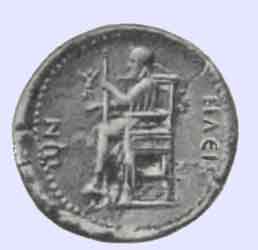
Elis Coin with Zeus Statue of Pheidias, Text "Ileion"
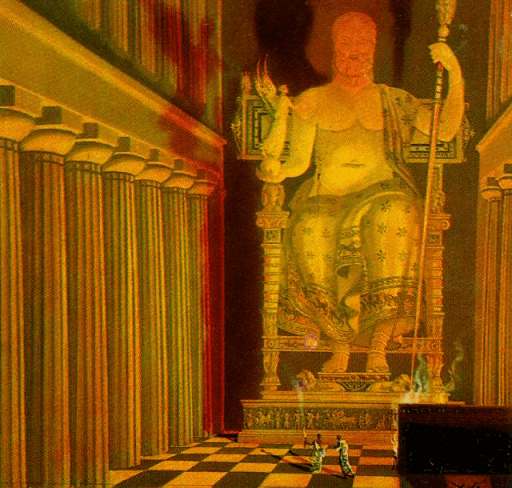
The Colossal Statue of Zeus in Olympia (one of the Seven Wonders) by Salvador Dali
Another Artistic Image of the Zeus Statue
A 3D Render Reconstruction of the Zeus Temple
The statue of Zeus strikes terror into the hearts of all who see it. It is the custom of the athletes, as well as their fathers, brothers and trainers, to swear an oath beside the statue. With their hands on slices of boar's meat, they promise to obey the rules of the Olympic Games.
... The image was made by Pheidias, as is witnessed by an inscription written under the feet of Zeus: "Pheidias son of Charmides, an Athenian, made me"
Within the temple stand pillars, and inside also are porticoes above, with an approach through them to the image.
The god sits on a throne, and he is made of gold and ivory (...And the Greeks in my opinion showed an unsurpassed zeal and generosity in honoring the gods, in that they imported ivory from India and Aethiopia to make images...). On his head lies a garland which is a copy of olive shoots. In his right hand he carries a Victory, which, like the statue, is of ivory and gold; she wears a ribbon and--on her head--a garland. In the left hand of the god is a scepter, ornamented with every kind of metal, and the bird sitting on the scepter is the eagle. The sandals also of the god are of gold, as is likewise his robe. On the robe are embroidered figures of animals and the flowers of the lily.
The throne is adorned with gold and with jewels, to say nothing of ebony and ivory. Upon it are painted figures and wrought images. There are four Victories, represented as dancing women, one at each foot of the throne, and two others at the base of each foot. On each of the two front feet are set Theban children ravished by sphinxes, while under the sphinxes Apollo and Artemis are shooting down the children of Niobe.

Reconstruction of the frieze of the Zeus Statue with the killing of the children of Niobe by Artemis ( assumed to be a work of Colotes or Kolotis )

Reconstruction of the frieze of the Zeus Statue with the killing of the children of Niobe by Apollo (assumed to be a work of Pheidias)
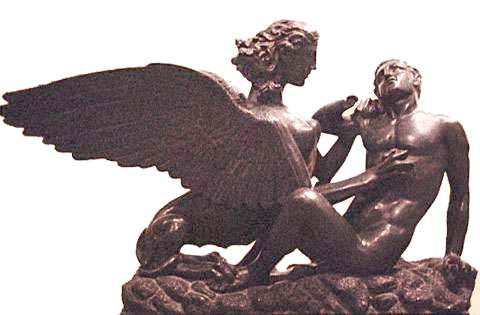
Sphinx with youth as victim; Roman copy from detail on throne of Pheidias' Zeus at Olympia (reconstructed from fragments) Vienna, Ephesus Museum. Credits: Barbara McManus, 1992 VROMA
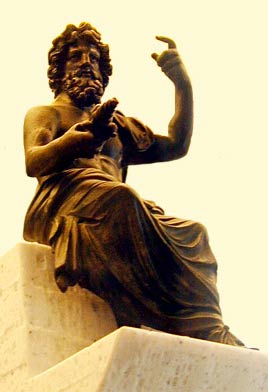
Seated bronze statuette of Jupiter holding a thunderbolt said to be based on Pheidias' Zeus at Olympia; Roman, first-second century AD, Paris, Louvre Museum. Credits: Barbara McManus, 1999 VROMA
Between the feet of the throne are four rods, each one stretching from foot to foot. The rod straight opposite the entrance has on it seven images; how the eighth of them disappeared nobody knows. These must be intended to be copies of obsolete contests, since in the time of Pheidias contests for boys had not yet been introduced.1 The figure of one binding his own head with a ribbon is said to resemble in appearance Pantarces, a stripling of Elis said to have been the love of Pheidias. Pantarces too won the wrestling-bout for boys at the eighty-sixth Festival. On the other rods is the band that with Heracles fights against the Amazons. The number of figures in the two parties is twenty-nine, and Theseus too is ranged among the allies of Heracles. The throne is supported not only by the feet, but also by an equal number of pillars standing between the feet. It is impossible to go under the throne, in the way we enter the inner part of the throne at Amyclae. At Olympia there are screens constructed like walls which keep people out.
Of these screens the part opposite the doors is only covered with dark-blue paint; the other parts show pictures by Panaenus. Among them is Atlas, supporting heaven and earth, by whose side stands Heracles ready to receive the load of Atlas, along with Theseus; Perithous, Hellas, and Salamis carrying in her hand the ornament made for the top of a ship's bows; then Heracles' exploit against the Nemean lion, the outrage committed by Ajax on Cassandra, Hippodameia the daughter of Oenomaus with her mother, and Prometheus still held by his chains, though Heracles has been raised up to him. For among the stories told about Heracles is one that he killed the eagle which tormented Prometheus in the Caucasus, and set free Prometheus himself from his chains. Last in the picture come Penthesileia giving up the ghost and Achilles supporting her; two Hesperides are carrying the apples, the keeping of which, legend says, had been entrusted to them. This Panaenus was a brother of Pheidias; he also painted the picture of the battle of Marathon in the painted portico at Athens.
On the uppermost parts of the throne Pheidias has made, above the head of the image, three Graces on one side and three Seasons on the other. These in epic poetry are included among the daughters of Zeus. Homer too in the Iliad says that the Seasons have been entrusted with the sky, just like guards of a king's court. The footstool of Zeus, called by the Athenians thranion, has golden lions and, in relief, the fight of Theseus against the Amazons, the first brave deed of the Athenians against foreigners.
On the pedestal supporting the throne and Zeus with all his adornments are works in gold: the Sun mounted on a chariot, Zeus and Hera, Hephaestus, and by his side Grace. Close to her comes Hermes, and close to Hermes Hestia. After Hestia is Eros receiving Aphrodite as she rises from the sea, and Aphrodite is being crowned by Persuasion. There are also reliefs of Apollo with Artemis, of Athena and of Heracles; and near the end of the pedestal Amphitrite and Poseidon, while the Moon is driving what I think is a horse. Some have said that the steed of the goddess is a mule not a horse, and they tell a silly story about the mule. ...
All the floor in front of the image has been paved not with white but with black tiles. A raised rim of Parian marble runs around the border of the black stone, to keep in the olive oil that is poured out. For olive oil is beneficial to the image at Olympia, and it is olive oil which keeps the ivory from being harmed by the marshiness of the Altis. On the Athenian Akropolis it is water, not olive oil, which benefits the so-called Parthenos. For the Akropolis is extremely dry owing to its excessive height, so that the image, being made of ivory, yearns for the dampness it brings.
Pausanias, Description of Greece, c. 150 AD
The colossal statue of Zeus in the Olympia Zeus Temple was produced by Pheidias around 432 BC (probably even later). The statue was 9.90 meters high, according to poet Kallinikos (3rd BC) whereas in total (including the stand) was 12.40 m. high, 6.65m long and 9.67 deep. The throne was decorated by his pupils and famous painters Panainos and Kolotis with mythological scenes. The bare body of Zeus was made from ivory and his robe was covered from golden sheets. His sandals were gold. His head was crowned by a silver olive wreath and the hairs and beard were made out of gold. In his right hand kept a Nike, made of gold and ivory and in his left a scepter with an eagle on top, made up from all the known metals. Pheidias describes that he was inspired by Homer's Iliad that describes Zeus brow and hairs.
I know that the height and breadth of the Olympic Zeus have been measured and recorded; but I shall not praise those who made the measurements, for even their records fall far short of the impression made by a sight of the image. Nay, the god himself according to legend bore witness to the artistic skill of Pheidias. For when the image was quite finished Pheidias prayed the god to show by a sign whether the work was to his liking. Immediately, runs the legend, a thunderbolt fell on that part of the floor where down to the present day the bronze jar stood to cover the place. Pausanias

Zeus Temple in Olympia
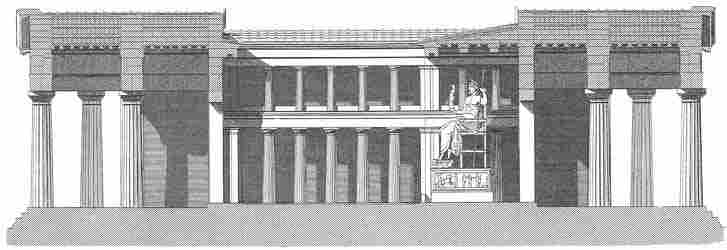
The giant Zeus Statue in the Temple
That Pheidias is extremely famous among all peoples who appreciate the reputation of his Zeus at Olympia, nobody doubts, but in order that those who have not seen his works may know that he is justly praised, I will offer some small points of evidence to prove who great his inventiveness was. To do this, I shall neither use as proof the beauty of the Zeus at Olympia, nor the size of the Athena which he made at Athens (since she is 26 cubits hight and is make of ivory and gold), but rather I shall use the battle of the Amazons which is carved in a circular pattern on the convex side of her shield; likewise on the concave side of it he represented the struggle of the gods and giants, and on her sandals that of the Lapiths and Centaurs, so fully did every part offer the opportunity for the application of his art. On the base is carved the scene which they call “the birth of Pandora,” with twenty gods present at the birth. The Victory is especially marvellous but experts admire the serpent and also the bronze sphinx which is placed below the point of her spear. Pliny the Elder, Natural History,
According to some descriptions a fire was burning that was used also to light the statue in the probably the dark temple. The colossal golden and ivory statue probably in this light looked even more impressive and explains the comments of Pausanias. Chrysostomos, in a speech given at the temple in 97 AD., said:
Φειδίας ὁ Ἀθηναῖος ἐκ χρυσοῦ καὶ ἐλέφαντος καλὴν εἰκόνα ἐποιήσατο ἀξίαν τοῦ πρώτου καὶ μεγίστου θεοῦ...Οἴονται δὲ, ὅτι ὁ ἄνθρωπος τὴν εἰκόνα ποτὲ βλέψας ἀπολύεται τῶν ἐν ἀνθρωπίνῳ βίῳ δεινῶν καὶ χαλεπῶν τε καὶ κακῶν.
"Pheidias of Athens produced a ivory gold image which honors the first and greatest of all gods... they say that if a man, with a heavy heart from grief and sorrow in life, will stand in front of the statue, he will forget all these". The statue was transported after 393 AD to Constantinople where it was destroyed by the great fire of Lauseion, at 476 AD. Some say that it was destroyed by Christians between 384 - 426 AD.
The descendants of Pheidias, called Cleansers, have received from the Eleans the privilege of cleaning the image of Zeus from the dirt that settles on it, and they sacrifice to the Worker Goddess before they begin to polish the image. Pausanias
Outside the Altis there is a building called the workshop of Pheidias, where he wrought the image of Zeus piece by piece. In the building is an altar to all the gods in common, Pausanias
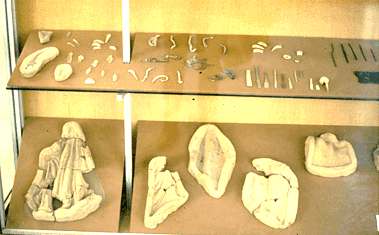
Fragments from the Zeus Statue found in the workshop of Pheidias
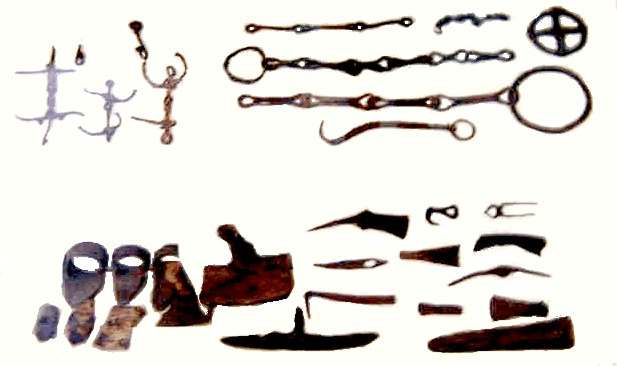
Tools found in Pheidias's Workshop, did he used these to produce his famous sculptures?
Images of the remains of the Workshop of Pheidias

A scene from the German Archaeological Institute excavation work in ancient Olympia (Temple of Zeus from East) during the latter 19th century. (Photo courtesy of the German Archaeological Institute of Athens) See : The last of the ancient champions...
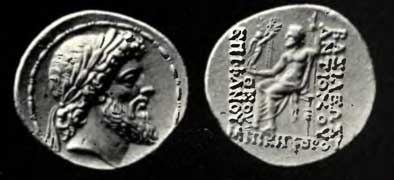
Antiochus IV Tetradrachm, Zeus Head amd Zeus with Nike.
Text (r) Basileos Antiochou (le) Theou Epiphanous, Below Nikephorou. A copy of the Statue of Zeus by Pheidias was set in a Temple near Antioch by Antiochus IV

A work inspired by the colossal Zeus statue: “The American Zeus” George Washington as Zeus the Lawgiver! (Horatio Greenough, 1840, completed after eight years of labor) The seminude Washington as expected shocked many Americans. “When Greenough carved his large statue of George Washington in the national Capitol, he omitted the drapery on the upper part of the body, obviously with the intention of drawing the attention of the spectator away from the dress to the person who wore it. He clearly followed in this respect the practices of the Greeks, and more especially the pattern set by Pheidias in his colossal Zeus in Olympia. The Greeks might omit the drapery with impunity, for they were as a race intensely fond of the nude. Greenough, imitating them in the face of very pronounced racial and religious prejudices against the nude, committed the unpardonable mistake of copying not the spirit of a past art but its accidental expression. Instead of accomplishing his end, therefore, by omitting the drapery, he achieved the opposite, for the drapery is "conspicuous by its very absence." Edmund von Mach, Greek Sculpture. “Did anybody ever see Washington naked! It is inconceivable. He had no nakedness, but I imagine, was born with his clothes on and his hair powdered, and made a stately bow on his first appearance in the world” Nathaniel Hawthorne A trip to Washington
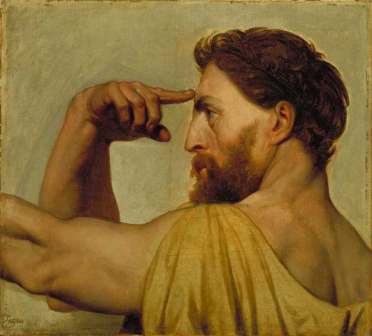
A Study of Pheidias from the Apotheosis of Homer by Ingres
| Ancient Greece
Science, Technology , Medicine , Warfare, , Biographies , Life , Cities/Places/Maps , Arts , Literature , Philosophy ,Olympics, Mythology , History , Images Medieval Greece / Byzantine Empire Science, Technology, Arts, , Warfare , Literature, Biographies, Icons, History Modern Greece Cities, Islands, Regions, Fauna/Flora ,Biographies , History , Warfare, Science/Technology, Literature, Music , Arts , Film/Actors , Sport , Fashion --- |

